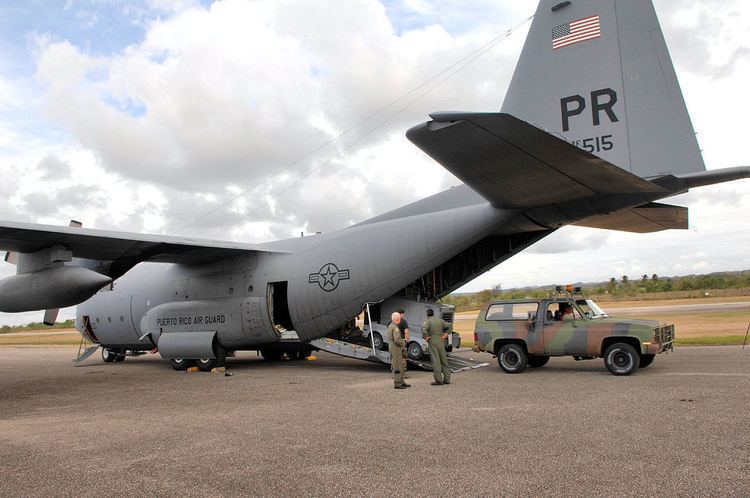Active 1944 – present Branch Air National Guard Role Airlift | Type Squadron | |
 | ||
Part of | ||
The 198th Airlift Squadron (198 AS) is a unit of the Puerto Rico Air National Guard 156th Airlift Wing located at Muñiz Air National Guard Base, in Carolina, Puerto Rico. The 115th is equipped with the C-130E Hercules.
Contents
World War II
Established in late 1944 at Peterson Field, Colorado as the 463d Fighter Squadron. Trained under XXII Bomber Command as a Very Long Range P-47N Thunderbolt bomber escort squadron, programmed for B-29 Superfortress escort duty from Okinawa. For four months they received combat training for long-range escort, strafing, and dive-bombing. Training delayed due to P-47N aircraft non-availability, finally equipped in the late spring of 1945 with the long-distance fighters.
Deployed to Okinawa in June 1945 as part of the 507th Fighter Group and prepared for the invasion of Japan along with the 413th and 414th Fighter Groups, all equipped with P-47N. On 1 July 1945 it began flying airstrikes from Ie Shima, targeting enemy ships, railroad bridges, airfields, factories, and barracks in Japan, Korea, and China. On 8 August 1945 the group escorted B-29 bombers on a raid, shooting down several Japanese fighters.
The squadron flew some long distance fighter-bomber sweeps over Japanese Home Islands 1 July 1945 – 14 August 1945 but never performed operational B-29 escort missions due to the end of the war in August.
Remained in Okinawa until inactivated in May 1946.
Puerto Rico Air National Guard
The wartime 463d Fighter Squadron was re-designated as the 198th Fighter Squadron, and was allotted to the Puerto Rico Air National Guard, on 24 May 1946. It was organized at Isla Grande Airport, San Juan, Puerto Rico, and was extended federal recognition on 23 November 1947 by the National Guard Bureau. The 164th Fighter Squadron was bestowed the lineage, history, honors, and colors of the 463d Fighter Squadron. The squadron was equipped with F-47N Thunderbolts and was assigned to the Puerto Rico Air National Guard, operationally gained by Fourteenth Air Force, Air Defense Command.
Air Defense mission
The mission of the 198th Fighter Squadron was the air defense of Puerto Rico. The short runways of Isla Grande Airport at the time did not allow safe jet operations. The squadron was forced to move its aircraft to the runways at the still under-construction San Juan International Airport maintaining the rest of its organization at Isla Grande Airport. The 198th was upgraded to F-86D day/night/all-weather Sabre Interceptors.
Tactical Fighter mission
On 15 October 1962, the Puerto Rico Air National Guard was expanded to a Group status, and the 156th Tactical Fighter Group was recognized and activated by the National Guard Bureau. The 156th was transferred to Tactical Air Command, with the 198th becoming at Tactical Fighter Squadron and assigned to the 156th TFG. Other squadrons assigned into the group were the 156th Headquarters, 156th Material Squadron (Maintenance), 156th Combat Support Squadron, and the 156th USAF Dispensary. With the transfer to TAC, the 198th received F-86H Sabre tactical fighters.
In 1967, F-104C Starfighers (and an F-104D two-seat trainer) were assigned to the 156th, upgrading the group to Mach-2 supersonic tactical fighter-bombers, replacing the elderly F-86H Sabre fighter-bombers. The F-104C was equipped to carry bombs or rocket pods on under-wing and fuselage points. The upward-firing Lockheed C-2 rocket-boosted ejector seat was standard. The internal 20-mm rotary cannon of the F-104A was retained, as well as the ability to carry an AIM-9 Sidewinder air-to-air missile on each wingtip to fill an air defense interceptor mission.
In 1975, the F-104s were retired, the 198th being the last USAF unit to fly the Starfighters. They were replaced by A-7D Corsair II ground support aircraft. Although designed primarily as a ground attack aircraft, it also had limited air-to-air combat capability.
The terrorist attack was the largest on American Air Force Base since the Vietnam War. The hostage situation in Iran at the time overshadowed this incident in the news media. The eleven National Guard planes at Muñiz Air Base were alleged by socialist organizations to be destined for use against popular insurgents in El Salvador. These allegations were never proven and may have been self-serving.
In 1992 the A-7Ds were being retired, and they were replaced by Block 15 F-16A/B Fighting Falcons modified for Air Defense. The F-16 ADF was a standard block 15 model converted to air defense fighters for the Air National Guard, and would take over the fighter interception mission, providing the primary defense of North America against bombers and cruise missiles.
In March 1992, with the end of the Cold War, the 156th adopted the Air Force Objective Organization plan, and the unit was re-designated as the 157th Fighter Group. A few months later, on 1 June, Tactical Air Command was inactivated as part of the Air Force reorganization after the end of the Cold War. It was replaced by Air Combat Command (ACC).
In October 1995, in accordance with the Air Force "One Base – One Wing" policy, the status of the 157th was upgraded to a Wing; the 198th Fighter Squadron being assigned to the new 157th Operations Group.
Airlift Mission
In 1998, the Department of the Air Force issued the official order designating the 156th Fighter Wing as 156th Airlift Wing. The 156th was transferred to Air Mobility Command, being re-designated as the 156th Airlift Wing.
Beginning in June 1999, the major mission for the Wing became support of Operation Coronet Oak, which was transferred from Howard AFB, Panama when the base was closed as part of the turnover of the Panama Canal.
The mission also includes any other kind of contingency and logistics support. Aircrews provide theater mobility, embassy support and airdrops. They also fly people, food and mail.
